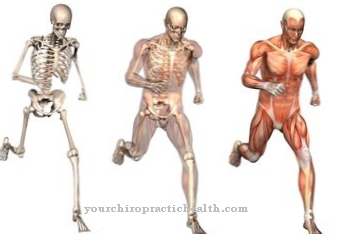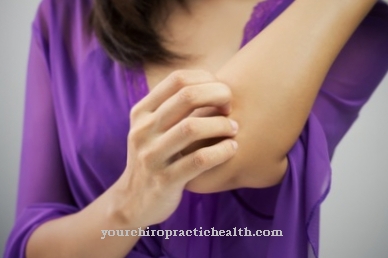The Nail hypoplasia is an underdevelopment of one or more fingernails or toenails and occurs mainly in the context of syndromes and embryopathies. A minor nail hypoplasia does not have to be of a disease value and does not require therapy. Disturbing nail hypoplasia can be compensated for with nail bed transplants.
What is nail hypoplasia?

© designua - stock.adobe.com
Hypoplasias are malformations that can affect any tissue in the body. In medicine, hypoplasia is an underdevelopment of the tissue. The complete non-system is to be distinguished from this and is called aplasia. Hypoplasia can affect the nails, for example.
Nail hypoplasias fall into the group of malformations and are therefore dysplasias. The underdevelopment of the nails occurs symptomatically in the context of various malformation syndromes and is then present from birth. Nail hypoplasia can affect a single fingernail or toenail, but it can also affect all of the patient's nails, and usually manifests as an abnormally small size.
The terms onychohypoplasia, microonychia and hypoonychia are used as synonyms for nail hypoplasia. Nail hypoplasia almost never occurs in the form of an acquired change in the nail apparatus. If the nail is damaged by chewing it, it is not called hypoplasia.
causes
In most cases, genetics are the cause of nail hypoplasia. The underdevelopment is often associated with malformation syndromes and, in this case, associated with further dysplasias. Nail hypoplasia occurs most frequently in the context of Huriez syndrome, osteoonychodysplasia, alcohol embryopathy, anti-epileptic embryopathy and Ellis-van-Creveld syndrome.
Coffin-Siris syndrome, the extremely rare DOOR syndrome, Maroteaux-Lamy syndrome and oto-onycho-peroneal syndrome or Zimmermann-Laband syndrome are also associated with underdevelopment of the nails. The primary cause of these syndromes is a genetic mutation that is sometimes inherited.
The situation is somewhat different with alcohol embryopathy and anti-epileptic embryopathy. In these cases, external factors are the cause of the underdevelopment. In embryopathies, the unborn child is harmed by the mother's exposure to toxins during pregnancy. Acquired hypoplasia only occurs in old age and is mainly caused by iron deficiency.
Diseases with this symptom
- Ellis van Creveld syndrome
- Alcohol embryopathy
- Osteoonychodysplasia
- Coffin-Siris Syndrome
- Iron deficiency
- Fetal alcohol syndrome
- DOOR syndrome
- Maroteaux-Lamy Syndrome
- Huriez syndrome
Diagnosis & course
Nail hypoplasia manifests itself in the form of small, unusually narrow nails. If the nails are severe, only remnants are present. The hypoplasia can be present on all nails or only on individual nails. Often the consistency of the nails is changed by the hypoplasia.
The other symptoms and malformations associated with nail hypoplasia depend on the primary cause of the underdevelopment. In the context of Huries syndrome, symptoms such as the onset of diffuse scler atrophy in the hands and feet, hyperkeratosis, sclerodactyly and dry skin or hypohidrosis are accompanying symptoms. In addition to the nails, organs and bones are affected by osteoonychodysplasia.
Ellis van Creveld syndrome primarily affects the ribs and heart. In addition, it is characterized by short stature. Short stature is also present in the Coffin-Siris syndrome, which is also associated with intellectual disability and general hypoplasia of the hands and feet. The symptoms accompanying nail hypoplasia are correspondingly variable.
When nail hypoplasia affects all of the nails in a hand or foot, it typically decreases from the first finger or toe. The doctor recognizes hypoplasia of the nails at first glance. The nail apparatus on the affected toes or fingers is clearly underdeveloped and sometimes does not cover the nail bed sufficiently. In most cases, the diagnosis is made immediately after birth, as hypoplasia is congenital in almost all cases.
The diagnosis of nail hypoplasia is usually preceded by a diagnosis of a particular syndrome or the two diagnoses overlap. Depending on the general appearance of the patient, the doctor will develop an initial suspicion of one of the syndromes mentioned. The suspected diagnosis is confirmed by imaging procedures and, if necessary, a molecular genetic analysis of the DNA.
The prognosis for patients with isolated hypoplasia of the nails is excellent. Since the underdevelopment of the nails only rarely occurs in isolation, this statement must be seen in relation. In the context of a syndrome, the prognosis depends primarily on the presence, severity and treatability of any organ dysplasia. Extremely weak and symptom-free hypoplasias of the nails are not considered to be pathological.
Complications
Nail hypoplasia, i.e. underdevelopment of the nails on the hands and feet, occurs primarily in the context of a genetic disease with the corresponding complications. One example is Huriez syndrome. In addition to the stunted nails, the person affected has a reduced sweat secretion (hypohidrosis) in this rare disease. The patient has very dry skin and quickly overheats.
Due to the dry skin, this is heavily stressed and excessive cornification occurs (hyperkeratosis). In addition, these patients have an increased risk of developing squamous cell carcinoma. Drinking alcohol during pregnancy can also cause nail hypoplasia. Depending on when the alcohol was consumed during pregnancy, typical consequences arise for the infant.
In the first trimester there are mainly malformations of the internal organs, such as the heart or the kidney. A smaller skull (microcephaly) and a smaller brain (microencephaly) can also be added. It is not uncommon for the child to abort. The greatest risk of miscarriage arises during the second trimester. Developmental disorders can also be observed here.
The third and last trimester is mainly characterized by physical and mental development, so that alcohol consumption can lead to severe mental development disorders and growth disorders in the child.
When should you go to the doctor?
In the case of nail hypoplasia, treatment by a doctor is not always necessary. As a rule, the person affected can decide for themselves whether the symptoms of nail hypoplasia need to be treated or not. In many cases, the aesthetic complaints can lead to depression or reduced self-esteem. In such a case, nail hypoplasia can be treated. It may also be necessary to seek advice from a psychologist so that there are no further inferiority complexes.
Furthermore, an examination by the doctor makes sense if the skin is very dry and there is less perspiration. Nail hypoplasia can also be associated with other complications, such as malformations of the heart or kidneys. Such complaints must always be examined and treated by a doctor. Growth disorders can also occur in children and these must be monitored by a doctor. If the nail hypoplasia only relates to complaints of the nails and skin, a transplant can solve these complaints relatively easily.
Doctors & therapists in your area
Treatment & Therapy
A mild, symptom-free nail hypoplasia does not require therapy. Since the nail changes usually occur as part of a syndrome, priority should be given to the other symptoms of the syndrome, even in the case of severe hypoplasia of the nails. This is especially true for the treatment of vital organs. If the nail bed is completely unusable, the dysplasia can possibly be corrected.
In most cases, this correction takes the form of a nail bed transplant. The deformed nail bed is excised during this operation. In most cases, the resulting hole is covered with a skin graft. If the skin has grown together, artificial nails can be used.
Since the focus in the treatment of nail hypoplasia is primarily on a cosmetic improvement, this type of nail bed transplant is sufficiently successful. Other people will hardly be able to identify the malformation or not at all. The quality of life of those affected increases and psychological problems due to the cosmetic deficiency are prevented.
Outlook & forecast
In most cases, nail hypoplasia does not lead to any specific complications or discomfort. If the symptom is minor, no direct treatment is necessary. As a result of the symptom, the patients mainly suffer from very small and narrow nails. The result is very dry skin and cracked nails. These can be treated with the help of cosmetic products or with a nail transplant.
In many cases, however, not only the nails are affected. Most patients also suffer from malformations of the heart or from intellectual disability if the nail hypoplasia was caused by Ellis-van-Creveld syndrome.
If the malformations on the nails do not bother the patient further, no treatment is necessary. There is no pain or discomfort. However, an examination of the other organs should take place so that a serious syndrome can be excluded. If the nails are not visually appealing, a nail bed transplant can also be carried out. There were also no further complaints. In women in particular, nail hypoplasia can lead to psychological complaints and reduced self-esteem, since on average the visual appearance is more important for them than for men.
Complications or a serious course usually only occur if the nail hypoplasia is triggered by another syndrome.
prevention
An expectant mother can at least prevent nail hypoplasia in connection with alcohol embryopathy by staying abstinent during the pregnancy and thus protecting the unborn child from the harmful effects of alcohol. In connection with acquired nail hypoplasia, iron consumption is considered preventive.
You can do that yourself
In the case of nail hypoplasia, no possibilities for self-help are known. This is just a symptom that sometimes occurs in certain congenital diseases and cannot be changed by taking measures yourself. In the context of the underlying diseases, however, this symptom is usually not the main problem.
The patient's quality of life is largely restricted by other physical and, in some cases, mental disabilities of these diseases. If the nail hypoplasia is weak, no treatment is often necessary for this symptom anyway. Even a noticeable deformation does not cause any complications, discomfort or pain, so that for health reasons neither treatment nor self-medication would be necessary. However, it can still happen that the patient suffers from inferiority complexes due to the nail hypoplasia and psychological problems arise as a result. But this will only be the case if the malformations of the fingernails and toenails appear as the main symptom.
Since there are no options for your own treatment, a nail bed transplant can be performed as a cosmetic operation in these cases. However, through intensive psychological support, it is also possible that the quality of life of those affected can be improved even without surgical intervention. However, because of the many other possible symptoms, patients with nail hypoplasia often require lifelong care and support.





.jpg)






.jpg)



.jpg)










.jpg)
